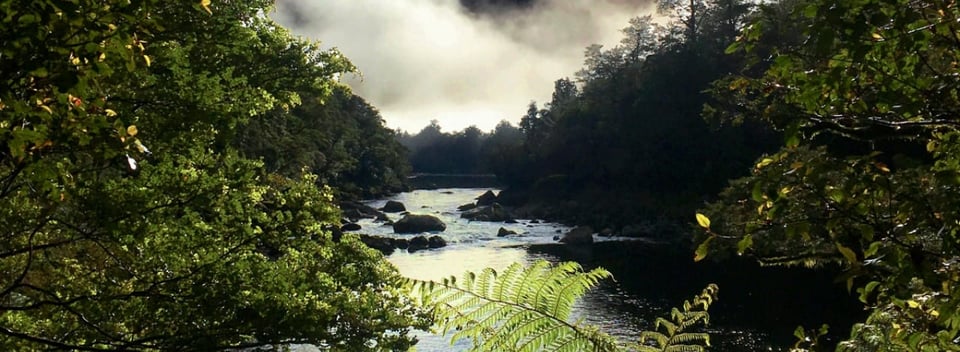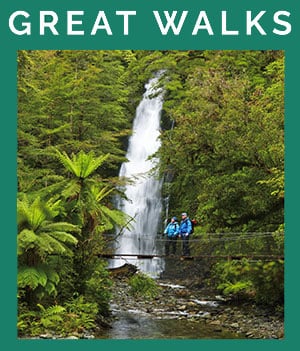
The Best Time to Hike the Milford Track
Many people (including some of us here at Trails!) believe that the best time to walk the Milford Track is when huge waterfalls tumble off the cliff tops and an eerie fog seeps through enchanting forests. At New Zealand Trails, we believe there's never a bad time to do it during the hiking season, which begins in late October and ends before the winter snow arrives in late April.
It’s rare for a hiking adventure to be enhanced by moody weather, but on the Milford Track, this is exactly the kind of climate that brings the environment to life. Whilst trekking this trail, it is possible to experience four seasons in one day! It’s not uncommon for calm, picture-perfect sunshine to disappear in seconds. Have no fear though, if anything, this means trampers (our word for hikers) see way more than they would have expected.
Here’s our handy guide to what types of weather to expect on the Milford Track, as well as an introduction to the flora and fauna of this iconic New Zealand walking track. Whatever time of year you choose, make sure you are ready to embrace the special charms that are associated with hiking in this unique climate. It’s also a hike that’s packed with history!

We love to describe the Fiordland wilderness as 'lush' and 'untouched', for good reason.
In 1908, British poet Blanche Baughan labelled the Milford Track the ‘finest walk in the world’. Over 100 years later, the grand mountains and wide valleys are still as impressive as ever. The trail winds through the heart of Fiordland, a region known for its lush rainforests, glacial valleys, thundering waterfalls and bright, crystal-clear rivers. Water is what makes these verdant and otherworldly landscapes so magical, with Fiordland being known for its high levels of rainfall. The Milford Track itself averages 182 days of rainfall a year. To say it rains from time to time here is an understatement, but locals tend to agree that Milford Sound is best experienced in the rain. Following a rain shower, waterfalls such as the Giant’s Gate Falls multiply rapidly in size and the forces that shape this rugged landscape awaken in vibrant technicolour.
Seasonal hiking on the Milford Track
During the Spring months from September to November, daily highs hover between 13-16 degrees Celsius (55-61 F), with lush new growth and alpine flowers adding colour and life to the trail. Like spring in most parts of the world, New Zealand’s weather can be unpredictable, so it pays to be prepared.
The summer months of December, January and February are relatively warm, with daily highs hovering between 18-20 degrees Celsius (64 – 68 F). It's usually in January and February when the classic summer weather arrives and walkers in these busiest months can experience the warmer temperatures and long summer twilights. Summer is also the best time of year for clear views of the track’s panoramic mountain-scapes.
Autumn (Fall) takes place during the months of March, April and May and can often bring the most settled weather of the year although the days begin to get shorter and temperatures cooler – daily highs sit between 12-19 degrees Celsius (54-66 F). One thing about autumn which surprises many overseas visitors is the evergreen forest as over 90% of New Zealand's native flora maintains its lush green foliage year-round.
Winter arrives on the Milford Track in late May and runs through to August, bringing highs that hover around 9 degrees Celsius (48 F). Snow is common in the mountains and avalanches are a constant threat on the Milford Track – hiking during the wintertime is not recommended. Many of the bridges along the Milford Track are removed over winter to avoid damage from avalanches, so hikers need to be competent at crossing large, swift and icy rivers.
To make the most of your time on the Milford Track, it's best to prepare for all kinds of weather. When it does rain and water cascades down the mountainsides, the track takes on a life of its own, but please rest assured that the trail is well maintained, making for safe hiking during the walking season. And don’t let all this talk of rain put you off – yes, it’s renowned for the wet weather, but there are sunny days too!
See our guest photo galleries here for stunning pictures of Milford Sound in all weather conditions.

Incredible views await you along this world-class track.
Highlights of the Milford Track
Beginning at the northern tip of the expansive Lake Te Anau, the biggest lake on the South Island, the Milford Track traverses 53 kilometres of pure native forest and alpine magic. Ending with a short cruise across the spectacular Milford Sound, the trail showcases picture-perfect lakes, a huge ice field and a breath-taking mountain pass. After a zig-zag climb on day three to MacKinnon Pass, hikers are rewarded with a huge outlook across the Clinton and Arthur Valleys, a view that is peppered with mountain peaks. But, as we’ve mentioned above, it’s the waterfalls that make the Milford Track a cut above the rest.
The Sutherland Falls – the highest in New Zealand – plummet 580m (1900 ft) down from Lake Quill, a high-altitude glacial-fed lake, and can be seen on a side trip during day three. The colossal Giant's Gate Falls, which are especially magnificent after heavy rain, lies towards the end of day four, the final day of hiking. It’s the combination of dramatic mountain-scapes, suspension bridges, enchanting forests and torrential waterfalls that make the Milford Track world-famous.

An Ancient Trail
The Milford Track is built on an ancient Maori trading route, frequently travelled in order to collect pounamu (greenstone) at Milford Sound. The pioneering spirit came into play in the late 1800s when Europeans Quintin McKinnon and Ernest Mitchell were commissioned to explore a track up the Clinton Valley from the head of Te Anau.
Searching for a pass to give tourist access to Milford Sound, McKinnon and Mitchell endured Fiordland’s characteristic extremes of torrential rain and blazing heat for a month; slashing a trail through thick, lush rainforest up and over the mountain pass. After cutting the track, they kept on scouting for the route ahead – and this is when they stumbled upon Donald Sutherland’s track from the Arthur Valley to the Sutherland Falls. This was the birth of the Milford Track as we know it today.
Soon after the discovery, the track was opened up to tourists and for McKinnon, a Scotsman, the majority of his time for the next several years was spent guiding visitors on the walk.

Smiles all around in this wondrous place.
Flora and Fauna
The diverse and unique wildlife that thrives in the vast rainforest surrounding the Milford Track is plentiful. Keen bird watchers love their regular sightings of many native species including kea, weka, Fantail, morepork, tui, bellbirds and wood pigeons. Keep an eye out for New Zealand’s rarer birds such as kiwi, kaka and the endangered blue mountain duck – whio – which are only seen on the most pristine, remote and fast-flowing wilderness rivers.
There is equal diversity to be found amongst the trees and plants, including vast tracts of red beech, silver beech and mountain beech forests. Adding to this are the lower-lying podocarp forests which are home to magnificent totara, miro and rimu trees, carpeted by a lush understory of shrubs, ferns and epiphytes. The flora and fauna found along the Milford Track is totally unique – there are many examples here of species that exist nowhere else on earth.

Become one with the scenery amongst only-in-New-Zealand foliage.
For more information grab your free New Zealand Trails brochure here or get in touch now.
Other articles you may like:
- Routeburn and Milford Track – the best one-day hiking options
- Hiking the Milford Track in New Zealand
- Five Reasons Why Milford Sound is Best in the Rain
- What’s the Best Time for Hiking in New Zealand?
- Get your free New Zealand Trails guided tour brochure









Comments
Let’s talk – we’d love to hear what you think. Pop your details in below and have your say.
No one has commented on this page yet.
RSS feed for comments on this page | RSS feed for all comments